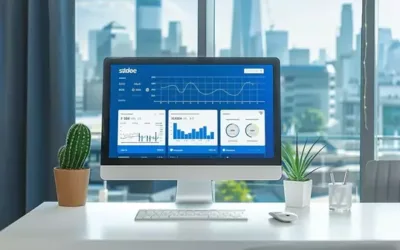Contents
When it comes to running an ecommerce business, one of the most critical decisions you’ll make is choosing the right payment terminal. A payment terminal, also known as a point-of-sale (POS) terminal, is the device used to process transactions and accept payments from customers. With so many options available, it can be overwhelming to choose the right one for your business. In this article, we’ll break down the key factors to consider when choosing a payment terminal, as well as the different types of terminals available, to help you make an informed decision.
We will also guide you through the research process and help you compare options, as well as provide tips on how to implement and test your chosen terminal. It’s important to remember that the right payment terminal can make all the difference when it comes to the success of your ecommerce business. A reliable and secure terminal can help you process transactions smoothly, build trust with customers, and increase sales. So, let’s dive in and explore the world of payment terminals and how to choose the best one for your ecommerce activity.
1- Factors to consider when choosing a payment terminal
When choosing a payment terminal, there are several important factors to consider to ensure that it meets the needs of your ecommerce business.
First and foremost, it’s crucial to consider the compatibility of the terminal with different payment methods. With the rise of digital payments, it’s increasingly important to ensure that your terminal can accept a wide variety of payment options, including credit and debit cards, mobile payments, and other digital wallets. This will not only provide convenience for your customers but also help you avoid losing potential sales from customers who can’t make a purchase because of a lack of payment options.
Another important factor to consider is security. As an ecommerce business, you’ll be handling sensitive financial information, so it’s crucial to choose a terminal that has robust security features. This includes EMV (Europay, Mastercard, Visa) compliance, which ensures that the terminal is able to process chip-enabled cards securely. Additionally, look for terminals that offer encryption, which ensures that customer data is protected during transactions, and fraud detection, which helps identify and prevent fraudulent transactions.
Integration with other systems, such as a POS or inventory management system, is also an important factor to consider. This will make it easy to manage transactions, inventory, and customer data in one place, reducing the risk of errors and increasing efficiency.
Fees and pricing structure is also a factor to consider when choosing a payment terminal. Some terminals come with a higher upfront cost, while others charge lower costs but with a higher percentage of transaction fees. It’s important to consider the long-term cost of the terminal, including any additional fees and charges, to ensure that it’s a cost-effective solution for your business.
Customer service and support is also an important factor to consider. Ensure that the provider offers reliable and responsive customer service and support, in case you need assistance with setting up, troubleshooting, or maintaining the terminal.
Finally, usability and ease of use are also important factors to consider. Choose a terminal that is easy to navigate and use, as this will help you and your employees process transactions quickly and efficiently, minimizing wait times and increasing customer satisfaction.
2. Types of payment terminals
When it comes to choosing a payment terminal, there are several different types available, each with their own unique features and benefits. Understanding the differences between these types of terminals can help you choose the one that best fits the needs of your ecommerce business.
Countertop terminals, also known as traditional POS terminals, are the most common type of payment terminal. They are typically used in brick-and-mortar businesses and are designed to be used on a countertop or other flat surface. They are typically stationary and connected to a power outlet, allowing them to process transactions using a wired connection. They come with a variety of features such as built-in printers and scanners, and they are also compatible with a range of payment methods including credit and debit cards, mobile payments, and other digital wallets.
Mobile terminals, on the other hand, are portable devices that can process transactions on-the-go. They typically connect to a cellular network or Wi-Fi and are powered by a rechargeable battery. This makes them ideal for businesses that need to process transactions at different locations, such as food trucks or pop-up shops. They also come in handy for businesses that make home deliveries or for businesses that require a mobile point of sale.
Virtual terminals are another type of payment terminal, which allows you to process transactions from any device with an internet connection. They typically work by logging into a web-based application, which allows you to enter transaction information manually. They are commonly used by businesses that take orders over the phone or by mail, allowing them to process transactions without needing a physical payment terminal.
Integrated terminals are a combination of countertop and virtual terminals. They typically come with a traditional countertop terminal that connects to the internet, allowing businesses to process transactions both in-store and online. This type of terminal is ideal for businesses that want to offer a seamless shopping experience for customers, whether they’re shopping in-store or online.
In summary, it’s important to consider the unique needs of your ecommerce business when choosing a payment terminal. Countertop terminals are perfect for brick and mortar stores, mobile terminals are great for businesses that need to process transactions on-the-go, virtual terminals are ideal for businesses that take orders over the phone or by mail and integrated terminals are perfect for businesses that want to offer a seamless shopping experience for customers.
3. Research and compare options
Once you’ve identified the type of payment terminal that best fits the needs of your ecommerce business, it’s important to research and compare different options from various providers.
The first step in this process is to look for reviews and testimonials from other businesses that have used the terminals you are interested in. This will give you an idea of the experiences of other businesses, and can help you identify any common issues or concerns. Additionally, you can look for certifications, awards and accreditation for the payment terminal providers, to ensure the quality of the service.
Next, compare the features and pricing of different terminals from various providers. Make a list of the features that are important to your business, such as compatibility with different payment methods, security features, integration with other systems, and customer service and support. Compare the features and pricing of different terminals to identify the one that offers the best value for your business.
Finally, it’s important to consider the long-term cost and scalability of the terminal. Some terminals come with a higher upfront cost, while others charge lower costs but with a higher percentage of transaction fees. Consider the long-term cost of the terminal, including any additional fees and charges, to ensure that it’s a cost-effective solution for your business. Additionally, ensure that the terminal can scale with your business as it grows, so you don’t have to replace it in the near future.
Researching and comparing options for payment terminals can be a time-consuming process, but it is an important step in ensuring that you choose the right terminal for your ecommerce business. By considering reviews, features, pricing, long-term cost, and scalability, you can ensure that the terminal you choose will meet the needs of your business today and in the future.
4. Implementation and testing
Once you’ve selected a payment terminal, it’s important to properly implement and test it to ensure that it works properly and is compatible with other systems.
The first step in this process is to test the terminal to ensure that it works properly. This includes testing the various payment methods that the terminal is compatible with, such as credit and debit cards, mobile payments, and other digital wallets. It’s also important to test any additional features, such as built-in printers or scanners, to ensure that they work as expected.
It’s also important to ensure that the terminal is compatible with other systems, such as a POS or inventory management system. This will ensure that you can manage transactions, inventory, and customer data in one place, reducing the risk of errors and increasing efficiency.
Once the terminal has been tested and is working properly, it’s important to train employees on how to use it. This includes training them on how to process transactions, troubleshoot any issues that may arise, and maintain the terminal. This will ensure that they are able to provide excellent customer service and keep wait times to a minimum.
It’s also important to have a plan in place for troubleshooting any issues that may arise with the terminal. This includes having a dedicated customer support team that can help you troubleshoot any issues and provide assistance when needed.
Implementing and testing a payment terminal is a crucial step in ensuring that it works properly and is compatible with other systems. By properly testing and training employees on how to use the terminal, you can ensure that your ecommerce business is able to process transactions smoothly, build trust with customers, and increase sales.
Conclusion
In conclusion, choosing the right payment terminal for your ecommerce business is a critical decision that can have a significant impact on the success of your business. It is important to consider factors such as compatibility with different payment methods, security features, integration with other systems, fees and pricing structure, customer service and support, and usability and ease of use.
Different types of terminals are available for different needs and use cases, such as countertop terminals, mobile terminals, virtual terminals, and integrated terminals. It’s important to research and compare different options to find the one that best fits the needs of your business. Properly testing and training employees on the usage of the terminal can ensure that your ecommerce business is able to process transactions smoothly, build trust with customers, and increase sales.
Keep in mind that the right payment terminal can make all the difference when it comes to the success of your ecommerce business. A reliable and secure terminal can help you process transactions smoothly, build trust with customers, and increase sales. By following the tips outlined in this article, you can choose the right payment terminal for your ecommerce business and set yourself up for success.








